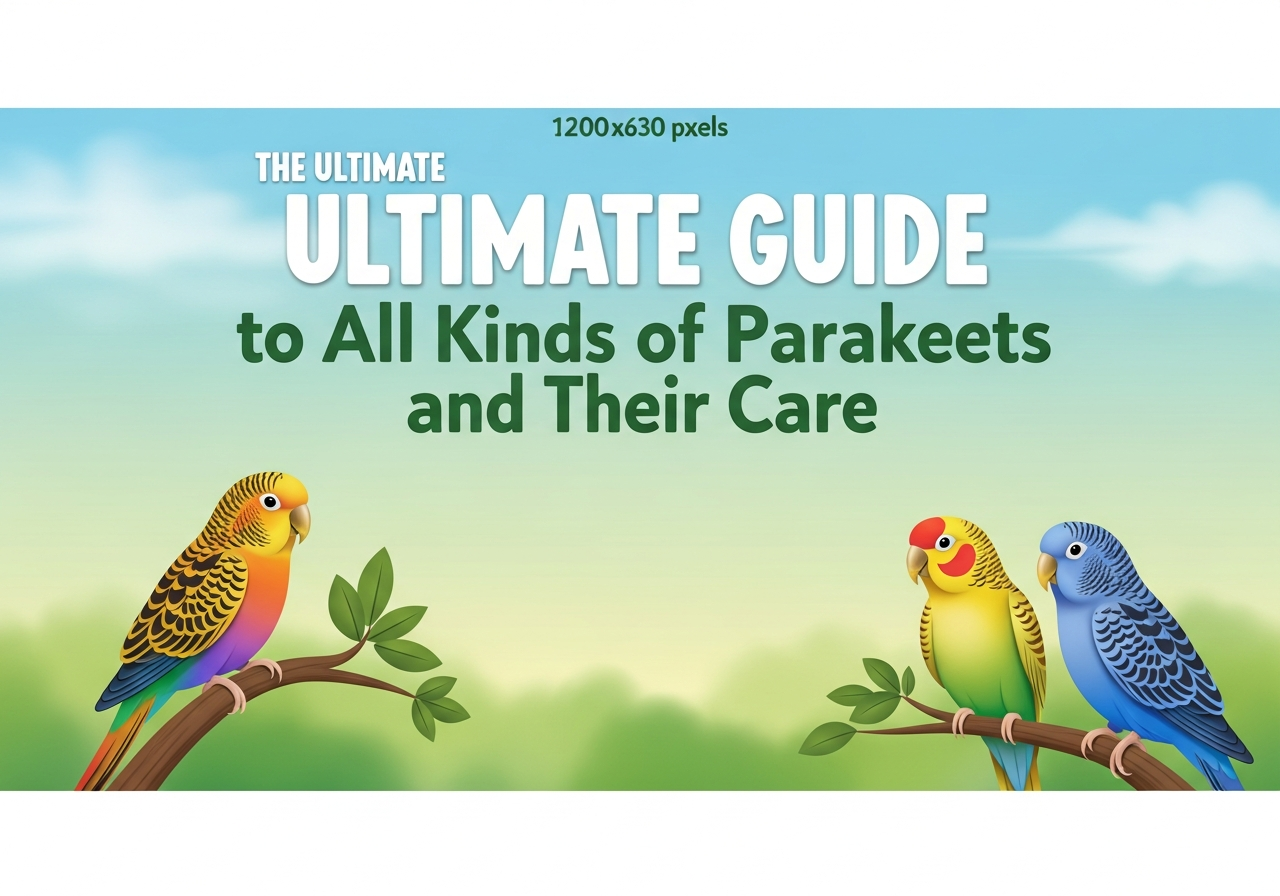
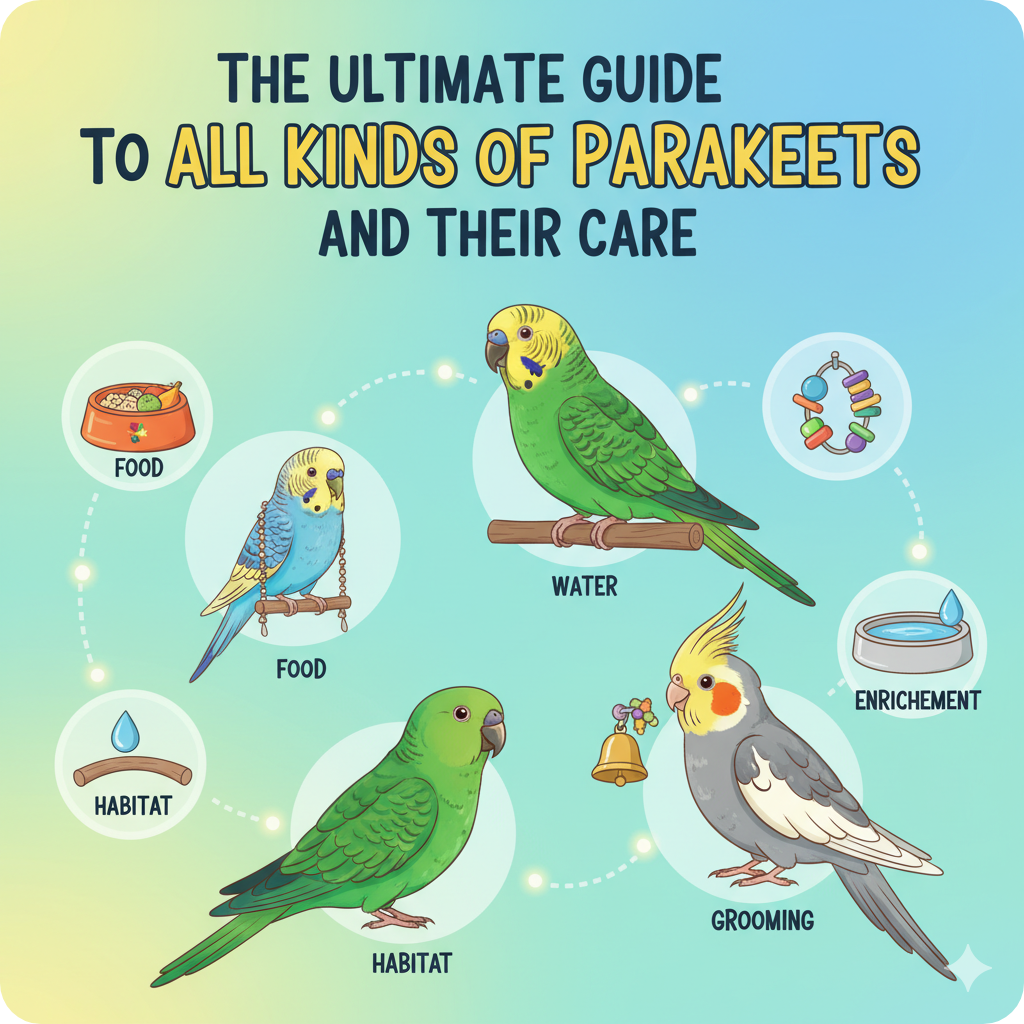
Introduction to Parakeets
Parakeets are some of the world’s most popular exotic pets. Known for their bright colors and friendly nature, these social birds make wonderful companions. The word “parakeet” refers to a wide range of small to medium-sized parrots with long tail feathers. There are over 100 different kinds of parakeets, each with its own unique needs and personality .
This guide provides everything you need to know about parakeet care. We will cover the different species, how to set up a perfect home, and the best parakeet diet. You will learn how to choose the right bird cages, the importance of small bird toys, and when to see an avian veterinarian. Our goal is to help you become a confident and knowledgeable pet owner.
Caring for a pet parakeet is a long-term commitment. With proper parakeet care, some species can live for decades. This journey is incredibly rewarding, bringing song and vibrant life into your home. Let’s get started.
What is a Parakeet?
Many people use the word “parakeet” to mean the common budgerigar, or budgie. However, it actually describes many different species. These exotic animals are part of the parrot family. People recognize them for their intelligence, sociability, and ability to mimic human speech.
All parakeets share some common traits. They have curved beaks perfect for cracking seeds. Their feet have two toes pointing forward and two pointing backward, which helps them grasp objects.
As highly social birds, they live in large flocks in the wild. This means a pet parakeet will need lots of interaction with you or another bird to stay happy .
Why Your Choice of Species Matters
Choosing the right type of parakeet is your first and most important decision. Different kinds of parakeets have vastly different needs.
- Experience Level: A budgie is a great choice for a first-time owner. Larger species, like the Alexandrine parakeet, need an experienced owner who understands their complex needs.
- Lifespan and Commitment: A budgie may live 7-15 years, while an Alexandrine parakeet can live for 30-40 years. Owning a bird is a long-term responsibility that can span decades .
- Space and Noise: Larger parakeets need very large bird cages and can be much louder. It’s crucial to match the bird to your living situation.
- Legal Considerations: Always check your local laws. For example, Monk Parakeets are illegal to own in some U.S. states. This includes California and Georgia because they can become invasive.
Comprehensive Profiles of Popular Kinds of Parakeets
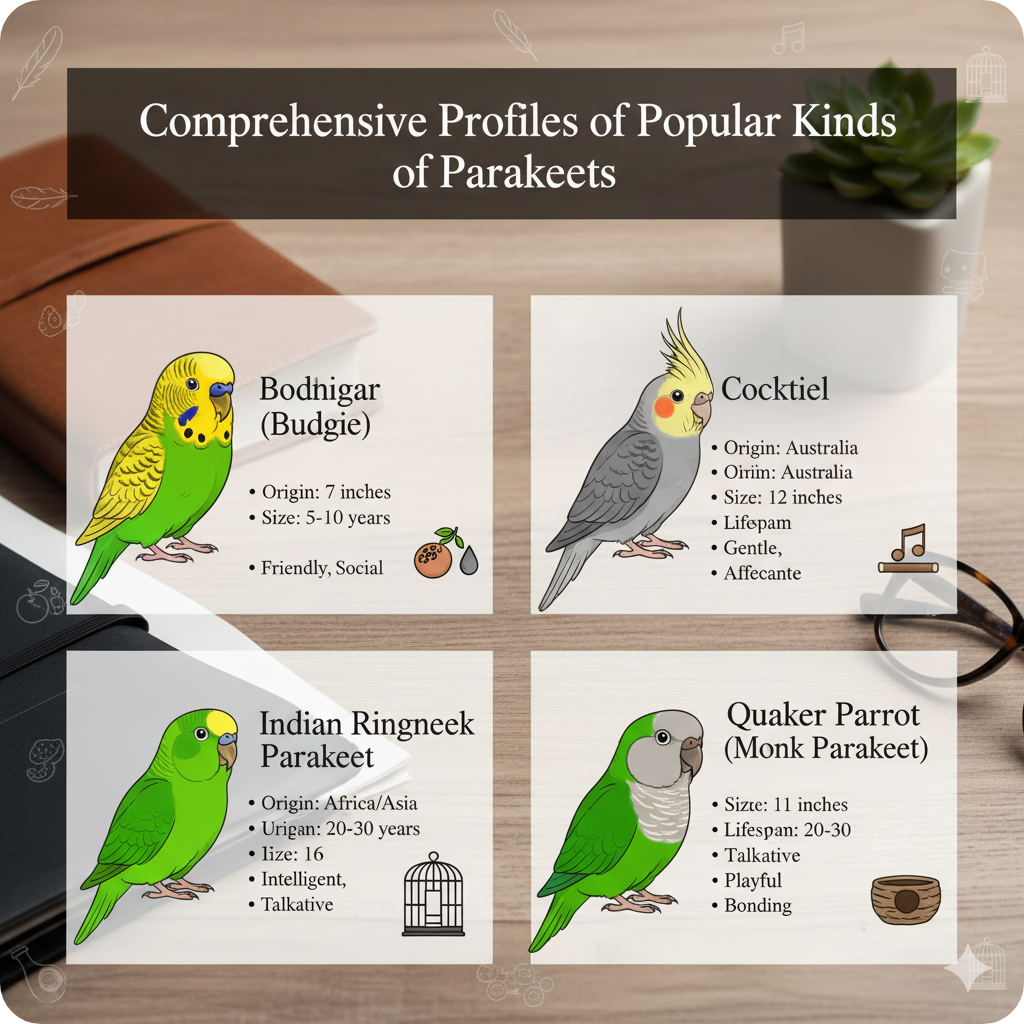
Here is a detailed look at some of the most popular kinds of parakeets you can keep as pets.
Budgie: A Common Kind of Parakeet
The Budgerigar is the most common parakeet and an ideal pet for beginners and families.
- Origin: Australia
- Size: 6-8 inches long
- Lifespan: 7-15 years with proper parakeet care
- Talking Ability: Good to excellent. They can learn hundreds of words .
Personality and Behavior: Budgies are curious, playful, and highly social. They bond strongly with their owners and enjoy learning tricks. Their small size doesn’t mean a small personality; they are active and entertaining to watch.
Care Requirements:
- Cage: A minimum of 18x18x18 inches, but a larger flight cage is always better.
- Diet: A high-quality pellet diet (60-70%), fresh vegetables, and limited fruits and seeds .
- Social Needs: They thrive with daily interaction and can be kept alone or in pairs.
Monk Parakeet (Quaker Parrot)
People recognize Monk Parakeets for their high intelligence and unique nest-building skills.
- Origin: South America
- Size: 11-12 inches long
- Lifespan: 20-30 years
- Talking Ability: Excellent. They are clear speakers with large vocabularies.
Personality and Behavior: Quakers have “big bird” personalities. They are clever, often described as architects, and love to rearrange their toys and cage items. They can form very strong, possessive bonds with one person.
Care Requirements:
- Cage: Requires a minimum of 24x24x24 inches.
- Diet: A varied diet of pellets, fresh foods, and healthy grains.
- Mental Stimulation: Their intelligence demands plenty of puzzle toys and foraging activities to prevent boredom.
Indian Ringneck Kinds Of Parakeet
These elegant birds are famous for their beauty and exceptional talking ability.
- Origin: India and parts of Africa and Asia
- Size: 14-17 inches long, including their long tail
- Lifespan: 25-30 years
- Talking Ability: Excellent, with remarkable clarity.
Personality and Behavior: Indian Ringnecks are independent and intelligent. They are not always “cuddly” but form strong bonds on their own terms. They go through a “bluffing” stage as teenagers, which requires patient, positive reinforcement training.
Care Requirements:
- Cage: A tall, spacious cage (at least 36x24x48 inches) to accommodate their long tails.
- Diet: Can be picky eaters, requiring patience to introduce pellets and fresh foods.
- Social Needs: Need daily mental stimulation and social interaction to prevent behavioral issues.
Alexandrine Parakeet
The Alexandrine parakeet is a large, calm, and gentle bird, making it a majestic companion.
- Origin: India and Southeast Asia
- Size: 22-24 inches long
- Lifespan: 30-40 years
- Talking Ability: Good.
Personality and Behavior: People recognize Alexandrines for their calm demeanor. They are less demanding than some other parakeets but form deep bonds with their family. Their natural call is a loud screech, but they can be capable talkers.
Care Requirements:
- Cage: A very large and sturdy cage (minimum 48x36x48 inches) is essential.
- Durability: Their powerful beaks require durable, large-parrot toys and cage accessories.
- Commitment: Their long lifespan means they are a lifelong commitment.
Comparison of Popular Parakeet Species
| Species | Average Size | Lifespan | Talking Ability | Best For |
|---|---|---|---|---|
| Budgerigar | 6-8 inches | 7-15 years | Good to Excellent | Beginners, families |
| Monk Parakeet | 11-12 inches | 20-30 years | Excellent | Experienced owners |
| Indian Ringneck | 14-17 inches | 25-30 years | Excellent | Experienced owners |
| Alexandrine Parakeet | 22-24 inches | 30-40 years | Good | Very experienced owners |
Perfect Habitat for All Kinds of Parakeets
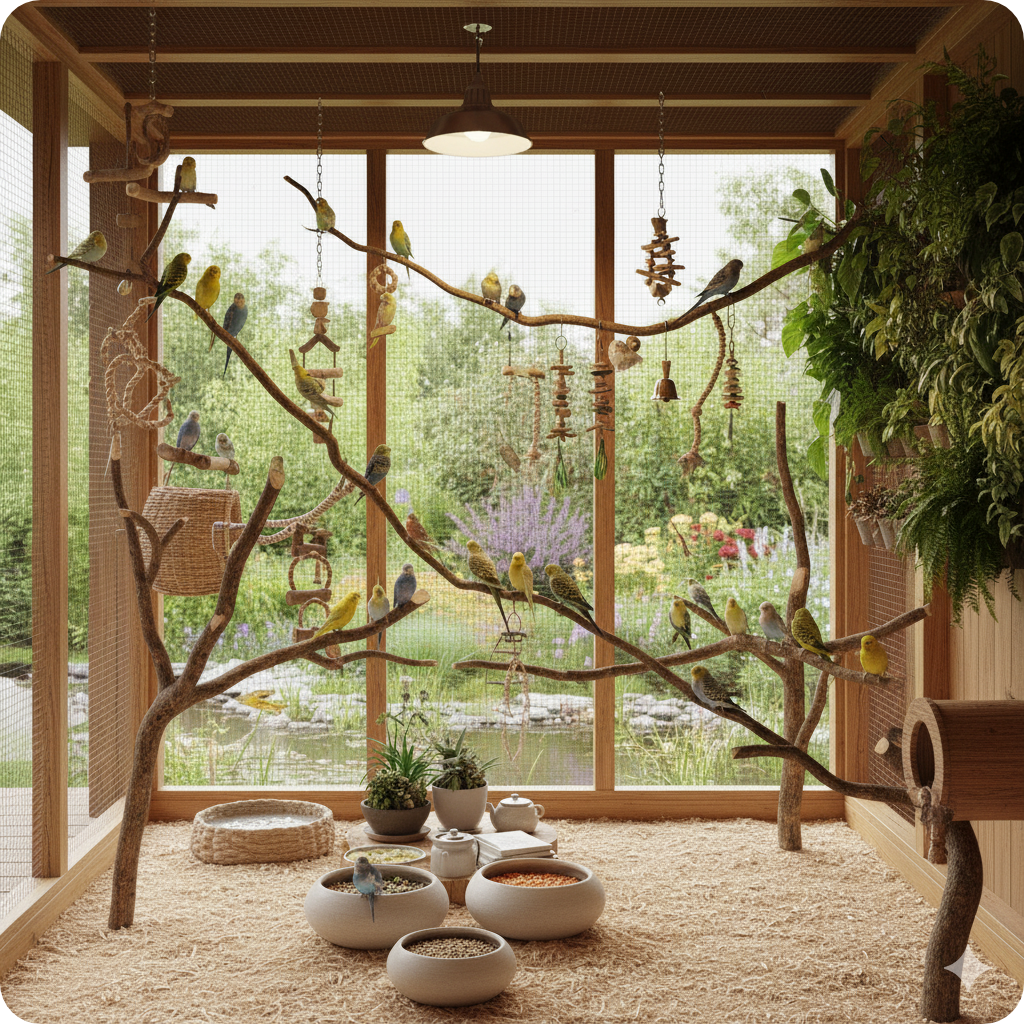
Creating a safe and stimulating home is a cornerstone of proper parakeet care.
Choosing the Right Cage
The cage is your bird’s castle. Its size, shape, and safety features are critical.
- Cage Size (Flight Cage): Always buy the largest cage you can. The minimum size for a single budgie is 18x18x18 inches, but they will be much happier in a larger flight cage. Larger species need significantly more space to fly and stretch their wings .
- Bar Spacing: This is a major safety concern. For small budgies, bar spacing should be 1/2 inch or less to prevent escape or injury. For larger parakeets, 3/4 to 1 inch is generally safe .
- Shape and Design: Rectangular cages offer more usable flight space than round ones. Horizontal bars on at least two sides are great for climbing.
Cage Placement is Key
Where you put the cage in your home greatly affects your bird’s well-being.
- The “Flock” Spot: Place the cage against a wall in a room where your family spends time, like the living room. This lets your bird feel part of the flock without being in a hectic traffic lane.
- Danger Zones to Avoid:
- Kitchens: Fumes from overheated non-stick (Teflon) pans are instantly lethal to birds .
- Drafty Areas: Keep away from air conditioning vents, doors, and windows.
- Direct Sunlight: A cage in direct sun can quickly overheat, causing fatal heatstroke.
Essential Cage Accessories
- Perches: Offer a variety of perches in different diameters, textures, and materials. Natural wood branches are excellent for foot health. Avoid sandpaper perches, as they can cause sores .
- Food and Water Dishes: Use stainless steel dishes for dry food, fresh food, and water. They are easy to clean and chew-resistant. Place them away from perches to avoid contamination .
- Toys and Enrichment: Small bird toys are not a luxury; they are a necessity. A good mix includes:
- Destructible Toys: Made of bird-safe wood, cardboard, and paper.
- Foraging Toys and Puzzle Toys: These make your bird work for treats, providing crucial mental exercise.
- Manipulative Toys: Bells, plastic chains, and acrylic toys encourage play.
- Rotate toys weekly to keep your bird interested and prevent boredom.
Nutrition: The Foundation of a Healthy Parakeet Diet

A balanced parakeet diet is the single most important factor for a long and healthy life.
The Ideal Daily Diet for Different Kinds of Parakeets
Forget the old image of a bird living on only seeds. A seed-only diet is high in fat.
It lacks important nutrients. This can cause health problems like obesity and heart disease. A proper diet includes:
- High-Quality Pellets (60-70%): These should be the base of your bird’s diet. The formulation provides complete and balanced nutrition.
- Fresh Vegetables (20-25%): Offer a colorful mix daily. Great choices are dark leafy greens (kale, spinach), broccoli, carrots, and bell peppers.
- Fruits and Treats (5-10%): Fruits are high in sugar, so give them in small amounts. Berries, melons, and apples (without seeds) are good options. Spray millet is a high-value training treat.
Always ensure fresh, clean food and water is available. Change water daily and wash dishes thoroughly.
Transitioning from a Seed Diet
If your bird is used to seeds, switching to pellets takes patience. Start by offering pellets in a separate dish. Gradually, over several weeks, decrease the amount of seeds while increasing the pellets. You can moisten pellets or mash them with a bit of fruit to make them more appealing.
Dangerous and Toxic Foods
Some common human foods are deadly to birds. You must strictly avoid:
- Avocado: Contains persin, causing cardiac failure.
- Chocolate and Caffeine: Contains toxins that cause vomiting, seizures, and death.
- Onions and Garlic: Can damage red blood cells, leading to anemia.
- Fruit Pits and Apple Seeds: Contain trace amounts of cyanide.
- Alcohol and High-Salt/Sugar Foods: Toxic to their delicate systems.
Health and Wellness: Proactive Parakeet Care

Birds are experts at hiding illness. Proactive health care and knowing the warning signs are essential.
Recognizing Signs of Sickness
Contact an avian veterinarian immediately if you notice any of these warning signs:
- Behavioral Changes: A bird that is fluffed up for long periods, sleepy, less vocal, or has lost interest in playing.
- Physical Symptoms: Discharge from the eyes or nose, wheezing, tail bobbing with each breath, or sitting on the cage floor.
- Dropping Changes: Significant changes in the color, consistency, or frequency of droppings can indicate digestive or systemic health issues.
Common Health Issues in Parakeets
- Nutritional Deficiencies: Caused by a poor diet. Not getting enough Vitamin A can cause breathing problems. A lack of calcium can make bones weak and lead to egg-binding in females.
- Respiratory infections can occur due to bacteria, viruses, or fungi. Drafty, dusty, or poorly ventilated environments are common contributors.
- Parasites: Mites, worms, and other parasites can cause itching, feather loss, and other health issues.
Preventative Health Care Strategies
- Regular Veterinary Care: An annual check-up with an avian veterinarian is crucial. They can detect problems early and provide professional veterinary care .
- Pet Insurance for Birds: Unexpected vet bills for an illness or accident can be costly. Pet insurance for birds is a smart way to manage these potential expenses, giving you peace of mind.
- Environmental Management: Keep the cage clean. Perform daily spot-cleaning and a weekly deep-clean to reduce harmful bacteria and parasites.
- Grooming: You may need to trim nails every few months. Most birds don’t need beak trims if they have proper perches and toys. You should discuss wing clipping with your vet as it is a personal choice.
Behavior, Socialization, and Training
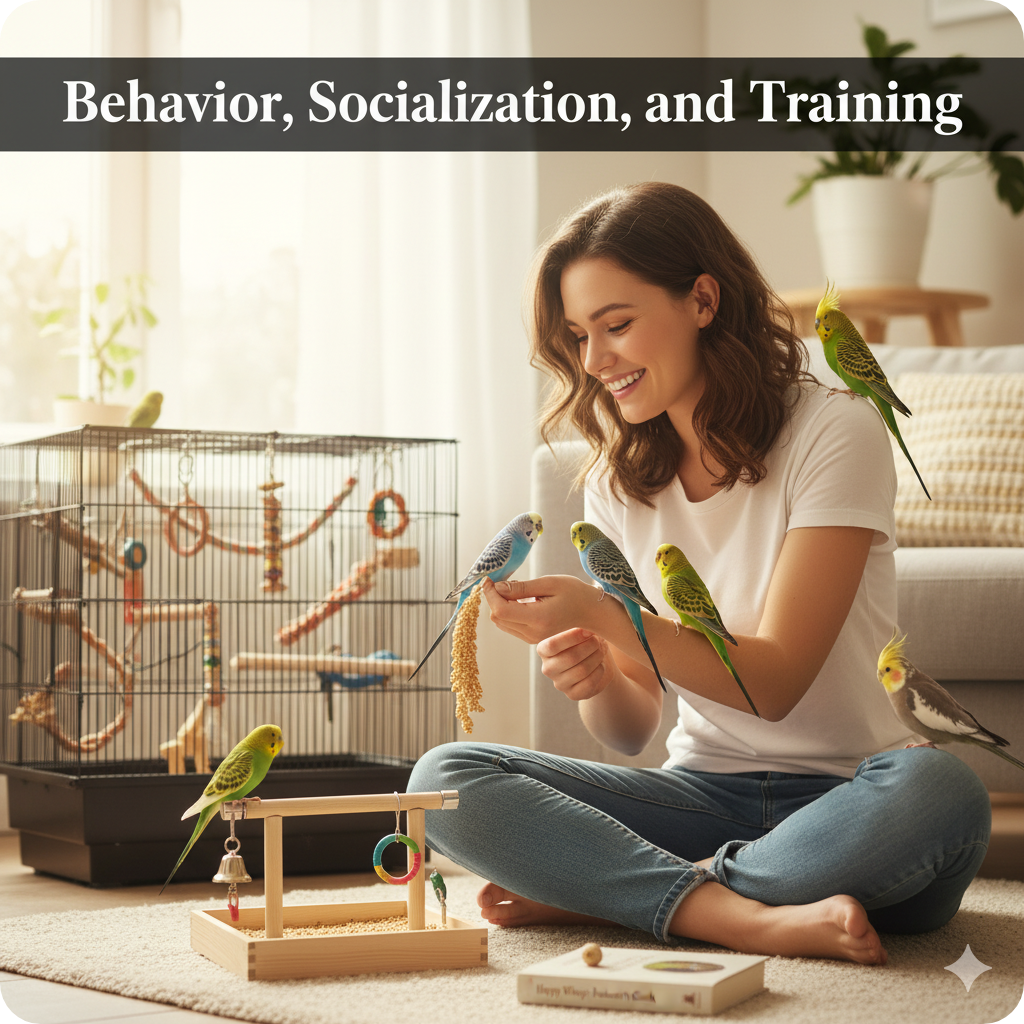
Understanding your parakeet’s behavior is key to a happy life together.
The Social Needs of Different Kinds of Parakeets
As flock animals, social interaction is not optional for parakeets—it’s a requirement.
- One Bird vs. Two: A single bird will bond very strongly with you but requires a lot of daily attention. Two birds will keep each other company but may be less tame with you. Consider your time and goals carefully.
- Human-Flock Integration: Spend time with your bird every day. Talk to it, offer treats, and let it out for supervised flight in a safe room. Your bird should see you as a trusted family member.
Training Your Parakeet
Training builds trust and provides mental stimulation. Always use positive reinforcement like treats and praise.
- Step-Up Command: This is the most important command. Gently press your finger against your bird’s lower chest and say “step up.” Reward it with a treat when it steps onto your finger.
- Target Training: Use a chopstick to guide your bird. Reward it for touching the stick. This is the foundation for teaching more complex tricks.
Addressing Behavioral Challenges
- Biting and Aggressive Behavior: Never yell or punish your bird. Fear, territoriality, or hormones often cause biting. Identify and address the root cause with patience.
- Excessive Screaming: Reward quiet behavior and ensure your bird gets enough sleep (10-12 hours of darkness nightly). Do not reward screaming with attention.
- Feather Plucking: This complex issue has both medical and psychological causes. First, see a vet to rule out health problems. Then, look at environmental factors like boredom, stress, or lack of social interaction.
Advanced Care and Long-Term Planning

Advanced Care and Long-Term Planning: Ensuring Your Parakeet’s Health, Happiness, and Lifelong Well-Being.
Teaching Different Kinds of Parakeets to Talk
Many kinds of parakeets can learn to talk, especially males. Here’s how to encourage them:
- Start Simple: Repeat one word, like their name, clearly and often. Parakeets find words with “d,” “t,” “k,” “p,” and “b” sounds easiest to say .
- Keep Sessions Short: Train for 10-15 minutes at a time when your bird is calm and focused .
- Be Patient and Positive: Not all parakeets will talk. Use a happy, enthusiastic voice and reward any attempt with praise.
Enrichment for All Kinds of Parakeets
A bored bird is an unhappy bird. Prevent this by:
- Creating a Foraging Curriculum: Hide treats in paper cups, cardboard boxes, or commercial puzzle toys.
- Rotating the Environment: Change the layout of perches and toys every few weeks to create a novel space.
- Social Enrichment: Talk to your bird, play soft music, or provide a view of the outside world (safely).
Future Care for All Kinds of Parakeets
A parakeet is a long-term commitment. Some species may be a part of your family for longer than your children live at home.
- Emergency Preparedness: Have a “go-bag” ready. Include a travel carrier, a few days’ worth of food, and any medications.
- Long-Term Care: For long-lived species, make formal plans in your will for who will care for your bird if something happens to you. Discuss this responsibility with the person beforehand.
Frequently Asked Questions (FAQs)
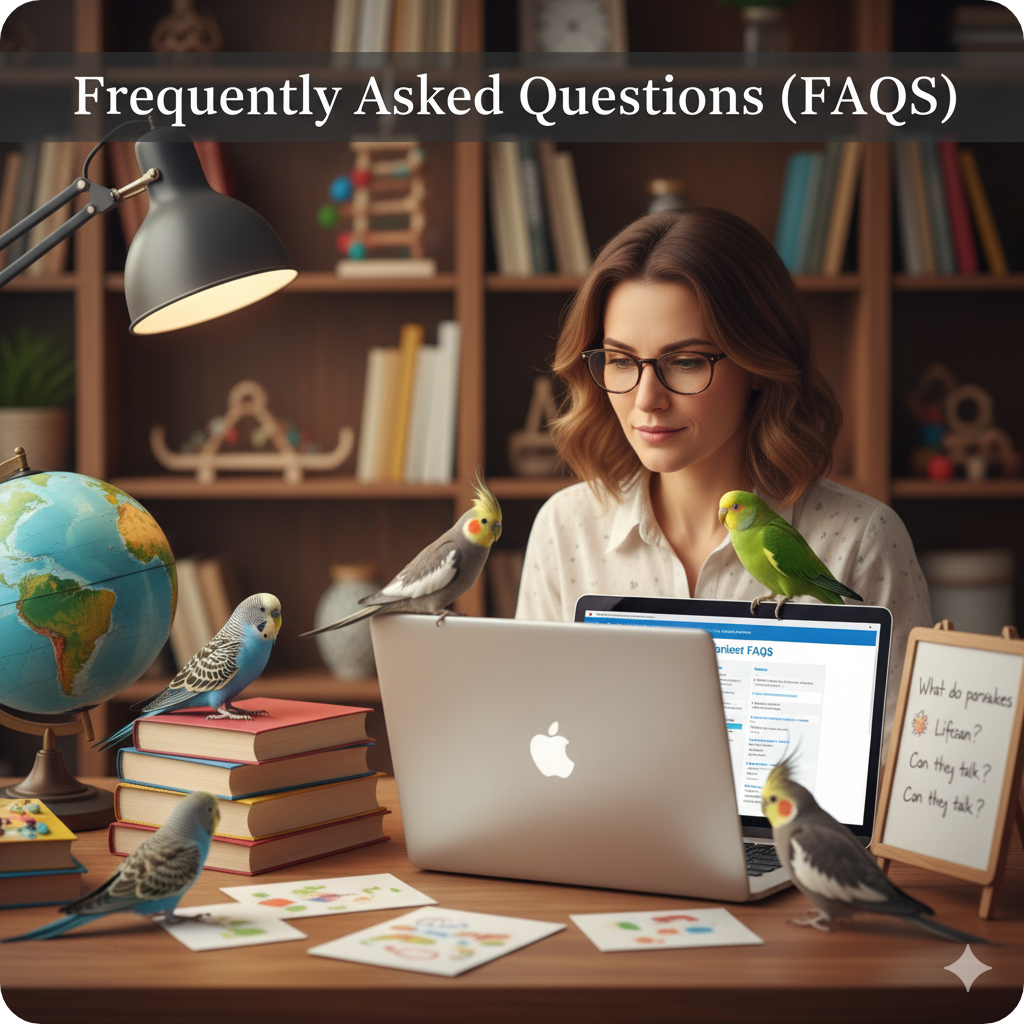
What is the best parakeet for beginners?
The Budgerigar (Budgie) is the best choice for first-time owners due to its small size, friendly personality, and manageable care requirements.
What should I feed my parakeet?
A proper parakeet diet includes high-quality pellets (60-70%), fresh vegetables (20-25%), and limited fruits/treats (5-10%). Avoid seed-only diets, which cause health issues.
What size cage does my parakeet need?
Get the largest flight cage possible. For one budgie, minimum dimensions are 18″L x 18″W x 24″H. Larger species need significantly more space to fly and move comfortably.
Do parakeets need veterinary care?
Yes. Regular check-ups with an avian veterinarian are essential for preventing health issues. Consider pet insurance for birds to manage unexpected emergency costs.
How much does a parakeet cost?
Budget $350-$800 for a budgie’s first year (bird, cage, setup). Ongoing costs run $500-$700 annually for food, toys, and veterinary care. Larger species cost significantly more.
Can parakeets learn to talk?
Yes! Many kinds of parakeets, especially males, can learn words and sounds. Budgies and Indian Ringnecks are particularly talented talkers with patient training.n vet also plays a role in providing grooming services (like nail trims) and is essential for diagnosing and treating illnesses. Regular veterinary care is a cornerstone of responsible ownership.
Conclusion: Your Journey as a Parakeet Owner

Choosing to welcome one of the many wonderful kinds of parakeets into your home is the start of a amazing friendship. From the cheerful budgie to the majestic Alexandrine parakeet, there is a perfect bird for every dedicated owner.
Proper parakeet care is a rewarding responsibility. By giving your parakeet a big cage, good food, and lots of love, you will have a happy, healthy friend. Remember to watch for warning signs of sickness and build a relationship with an avian veterinarian.
The song and vibrant energy a pet parakeet brings to a home is a special gift. With the knowledge from this guide, you are well-equipped to provide a fantastic life for your feathered friend.

Leave a Reply